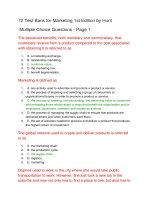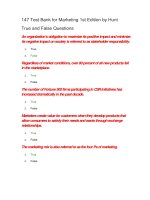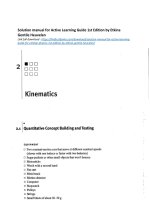Solution manual for marketing 1st edition hunt, mello
Bạn đang xem bản rút gọn của tài liệu. Xem và tải ngay bản đầy đủ của tài liệu tại đây (1.59 MB, 35 trang )
Instructor’s Manual - Chapter 2
Hunt / Mello:
Marketing
Chapter 2: Strategic Planning for a
Successful Future
Use this Instructor’s Manual to facilitate class discussion and incorporate the unique features of the text’s
highlights. Follow-up via the Connect exercises is then encouraged to provide a holistic understanding of the
chapter. Click here to access the Connect Instructor’s Manual for helpful suggestions, recommendations and
time-saving hints.
CHAPTER FORECAST
This chapter explores the importance of strategic planning in marketing. Executing a thoughtful strategic
marketing plan is the most likely path to sustainable business success. The chapter examines the role of a
mission statement, situation analysis, marketing strategy, global marketing strategy, and other elements of
an effective marketing plan. As you read through the chapter, consider the following key questions:
1. Why is strategic planning important for
marketing?
4. What tools can I use to analyze my firm’s
situation externally and internally?
2. What elements should a marketing plan
include?
5. What strategic directions can a firm take?
3. How do I evaluate the effectiveness of a firm’s
mission statement?
6. How does globalization affect marketing
strategy?
7. Why is strategic planning critical for nonprofit
organizations?
EXECUTIVE PERSPECTIVE
Michael Friloux
Senior Vice President of Business Development, Citynet
Michael Friloux, computer science major turned marketer, attributes his success
to social skills, work ethic and personal integrity. He explains how taking
responsibility for marketing yourself elicits success by answering the following
questions:
1. What has been the most important thing in making you successful at
your job?
2. What advice would you give soon-to-be graduates?
3. How is marketing relevant to your role at Citynet?
4. What do you consider your personal brand to be?
Woven into the chapter, you see how Michael later elaborates on:
1. The role of strategic planning in an organization (p. 31).
2. Why it’s important to clearly identify a firm’s target market (p. 38).
1
Instructor’s Manual – Chapter 2 | Hunt / Mello: Marketing © 2015 by McGraw-Hill Education
Instructor’s Manual - Chapter 2
Hunt / Mello:
Marketing
LEARNING OBJECTIVES
LO 2-1 Discuss the importance of strategic planning for marketing.
LO 2-2 Outline the five main components of the marketing plan.
LO 2-3 Analyze the characteristics of an effective mission statement.
LO 2-4 Explain the elements of a situation analysis.
LO 2-5 Illustrate the major strategic directions a firm might take.
LO 2-6 Discuss the strategic decisions involved in reaching international consumers.
LO 2-7 Discuss the importance of strategic planning for nonprofit firms.
KEY TERMS
competitive advantage (p. 41)
direct ownership (p. 46)
diversification (p. 40)
exporting (p. 44)
financial projections (p. 42)
franchising (p. 45)
joint venture (p. 46)
licensing (p. 45)
market (p. 34)
market development (p. 40)
market penetration (p. 39)
market summary (p. 34)
marketing plan (p. 31)
mission statement (p. 31)
multinational company (p. 38)
opportunities (p. 36)
positioning (p. 38)
product development (p. 39)
situation analysis (p. 34)
strategic planning (p. 31)
strategy (p. 37)
strengths (p. 35)
SWOT analysis (p. 35)
target market (p. 38)
threats (p. 36)
weaknesses (p. 35)
CONTENT OUTLINE
The following section provides the flow of information using the LEARNING OBJECTIVES as a guide, FIGURES
and TABLES as visuals to elaborate on key areas, KEY TERMS learners will need to take away from the course
and a notation of when to use POWERPOINT SLIDES with LECTURE NOTES to drive home teaching points.
There is also a reminder on when CONNECT activities can be used, as well as tying in SOCIAL MEDIA IN
ACTION to real-world applications of marketing products. This is created so that you can facilitate in-class or
online discussion effectively.
LO 2-1
Discuss the importance of strategic planning for marketing.
The Importance of Strategic Planning
PowerPoint
Slides
2
Introductory Slides:
Key Terms:
Strategic planning
Lecture Notes:
Whether you are
marketing yourself or
some other product,
strategic planning can
greatly increase the
likelihood of success.
Strategic planning is the
process of thoughtfully
defining a firm’s
objectives and
developing a method
for achieving those
objectives.
Instructor’s Manual – Chapter 2 | Hunt / Mello: Marketing © 2015 by McGraw-Hill Education
Instructor’s Manual - Chapter 2
Hunt / Mello:
Marketing
Firms must continually
undertake the task of
strategic planning.
Shifting conditions,
including changing
customer needs and
competitive threats,
ensure that what
worked in the past will
not always work in the
future, thus requiring
firms to modify their
strategy.
Strategic planning helps
to ensure that
marketers will select
and execute the right
marketing mix
strategies to maximize
success.
3
Instructor’s Manual – Chapter 2 | Hunt / Mello: Marketing © 2015 by McGraw-Hill Education
Instructor’s Manual - Chapter 2
Hunt / Mello:
Marketing
LO 2-1:
Outline the five main components of the marketing plan.
The Marketing Plan
LO 2-2
PowerPoint
Slides
4
LO 2-2:
Key Terms:
Marketing plan
Lecture Notes:
A marketing plan is part
of an organization’s
overall strategic plan,
which typically captures
other strategic areas
such as human
resources, operations,
equity structure, and a
host of other nonmarketing items.
The marketing plan is
an action-oriented
document or playbook
that guides the
analysis,
implementation, and
control of the firm’s
marketing strategy.
Creating a marketing
plan requires the input,
guidance, and review of
employees throughout
the various
departments of a firm,
not just the marketing
department.
The specific format of
the marketing plan
differs from
organization to
organization.
Most plans include an
executive summary,
situation analysis,
Instructor’s Manual – Chapter 2 | Hunt / Mello: Marketing © 2015 by McGraw-Hill Education
Instructor’s Manual - Chapter 2
Analyze the characteristics of an effective mission statement.
Mission Statement
Executive Summary
LO 2-3
Figure 2.1
Figure Information: Key Components of the Marketing
Plan
The five components of the marketing plan are
interlinked and connected. Each of the components
should be grounded in the firm’s overall mission,
which is ideally defined in a clear and succinct mission
statement.
PowerPoint
Slides
5
LO 2-3:
Hunt / Mello:
Marketing
marketing strategy,
financials section, and
controls section.
Key Terms:
Mission
statement
Insight Questions:
1. Who is involved in
developing the
marketing plan?
(Answer: Most
departments in a firm,
not just the marketing
department.)
2. What types of
objectives should be
considered in the
marketing strategy?
(Answer: specific,
measurable and
realistic objectives.)
3. Should a marketing
plan have a shortterm or long-term
vision? (Answer: Both;
and they should tie
into the organization’s
mission for long-term
sustainability.)
Lecture Notes:
The first step in
creating a quality
marketing plan is to
develop an effective
mission statement.
A mission statement is
a concise affirmation
of the firm’s long-term
purpose.
An effective mission
statement provides
employees with a
shared sense of
ambition, direction,
and opportunity.
A firm should begin
the process of
developing a mission
statement by
Instructor’s Manual – Chapter 2 | Hunt / Mello: Marketing © 2015 by McGraw-Hill Education
Instructor’s Manual - Chapter 2
6
Hunt / Mello:
Marketing
considering the
following classic
questions:
o What is our
business?
o Who is our
customer?
o What is our value to
the customer?
o What will our
business be?
o What should our
business be?
The firm should then
focus on instilling the
three primary
characteristics of a
good mission
statement:
o The mission
statement should
focus on a limited
number of goals.
o The mission
statement should
be customer
oriented and
focused on
satisfying basic
customer needs and
wants.
o Mission statements
should capture a
shared purpose and
provide motivation
for the employees
of the firm.
A firm’s mission
statement drives
many of the other
decisions it makes,
including how best to
market its goods and
services to consumers.
A sound mission
statement provides a
basis for developing
the marketing plan
and provides a
standard to ensure
Instructor’s Manual – Chapter 2 | Hunt / Mello: Marketing © 2015 by McGraw-Hill Education
Instructor’s Manual - Chapter 2
Explain the elements of a situation analysis.
Situation Analysis
o Market Summary
BCG Matrix
o SWOT Analysis
Internal Considerations
External Considerations
o Competition
LO 2-4
Figure 2.2
Hunt / Mello:
Marketing
that the business
never strays too far
from its core goals and
values.
The executive
summary serves as the
elevator pitch for the
marketing plan.
It provides a one- to
two-page synopsis of
the marketing plan’s
main points.
While the executive
summary is listed first,
firms should complete
this part of the
marketing plan last.
Key Terms:
Situation analysis
Market
Market summary
SWOT analysis
Strengths
Weaknesses
Opportunities
Threats
Insight Questions:
1. What does the BCG
Matrix determine?
(Answer: where the
product will fall in the
marketplace; this
serves as a starting
point for developing
marketing strategies to
address that market
position.)
Figure Information: The Boston Consulting Group
Matrix
The BCG matrix (1970) combines the two elements of
market growth and relative market share to produce
four unique product categories—stars, cash cows,
question marks, and dogs—each requiring a different
marketing strategy.
7
2. What quadrant would
represent the Apple
iPad? (Answer: cash
cow.)
3. What quadrant would
represent a new
iPhone application?
(Answer: question
mark.)
Instructor’s Manual – Chapter 2 | Hunt / Mello: Marketing © 2015 by McGraw-Hill Education
Instructor’s Manual - Chapter 2
Table 2.1
Table Information: Example SWOT Analysis for
McDonald’s
Companies like McDonald’s often complete a SWOT
analysis to identify and evaluate their strengths,
weaknesses, opportunities, and threats. Evaluating
internal and external considerations is extremely
important in determining a firm’s position and
competitive advantage.
PowerPoint
Slides
8
LO 2-4:
Hunt / Mello:
Marketing
Insight Questions:
1. Which elements of a
SWOT analysis are
internal
considerations?
(Answer: strengths
and weaknesses.)
2. Which elements of a
SWOT analysis are
external
considerations?
(Answer:
opportunities and
threats.)
3. What key words or
action-oriented words
do you see in the
example? (Answer:
effective, rigorous,
flexible, promotes,
positive, contributes.)
4. What qualitative and
quantitative measures
exist in the example
SWOT analysis?
(Answer: openended.)
Lecture Notes:
A situation analysis is
the systematic
collection of data to
identify the trends,
conditions, and
competitive forces
that have the
potential to influence
the performance of
the firm and the
choice of appropriate
strategies.
The situation analysis
comprises three
subsections: market
summary, SWOT
analysis, and
competition.
The market summary
sets the stage for the
situation analysis
section by focusing on
Instructor’s Manual – Chapter 2 | Hunt / Mello: Marketing © 2015 by McGraw-Hill Education
Instructor’s Manual - Chapter 2
9
Hunt / Mello:
Marketing
the market to which
the firm will sell its
products. A market is
the group of
consumers or
organizations that is
interested in and able
to buy a particular
product.
The market summary
describes the current
state of the market.
The market summary
would also consider
the growth
opportunities
internationally and
potential sales
through international
expansion.
One of the most
popular analysis tools
to describe the current
market is The Boston
Consulting Group
(BCG) matrix.
The BCG matrix
combines the two
elements of market
growth and relative
market share to
produce four unique
product categories—
stars, cash cows,
question marks, and
dogs—each requiring
a different marketing
strategy.
Star products combine
large market share
with a high growth
rate.
Cash cows are
products that have a
large market share in
an industry with low
growth rates.
Question marks have
small market share in
a high-growth
Instructor’s Manual – Chapter 2 | Hunt / Mello: Marketing © 2015 by McGraw-Hill Education
Instructor’s Manual - Chapter 2
10
Hunt / Mello:
Marketing
industry.
Dogs are products that
have small market
share in industries
with low growth rates.
The evaluation of a
firm’s strengths,
weaknesses,
opportunities, and
threats is called a
SWOT analysis.
The strengths and the
weaknesses aspects of
the analysis focus on
internal
characteristics.
o Strengths are
internal capabilities
that help the
company achieve its
objectives.
o Weaknesses are
internal limitations
that may prevent or
disrupt the firm’s
ability to meet its
stated objectives.
The opportunities and
threats aspects of the
SWOT analysis focus
on the external
environment.
Opportunities are
external factors that
the firm may be able
to capitalize on to
meet or exceed its
stated objectives.
Threats are current
and potential external
factors that may
challenge the firm’s
short- and long-term
performance.
While most marketing
plans examine direct
competitors
thoroughly, indirect
competitors typically
receive far less
Instructor’s Manual – Chapter 2 | Hunt / Mello: Marketing © 2015 by McGraw-Hill Education
Instructor’s Manual - Chapter 2
Connect
Assignment 2-1
Hunt / Mello:
Marketing
attention or are
overlooked entirely.
Indirect competitors
can take market share
away from a firm as
macro trends or
consumer preferences
change.
Topic: SWOT Analysis
By identifying which elements of a fictional company’s situation analysis fall into
each category, you will understand the key differences among each of the four
SWOT components.
Incorporate This Activity into Your Course. For tips on how to incorporate this
Connect exercise into your lesson, click here to access the Interactive Assignment
Guide.
LO 2-5
11
Insight Questions:
1. In a real SWOT analysis, what resources will you use to compose your SWOT
analysis?
2. For measurement and analysis, figure out which elements are quantitative, and
which ones are qualitative.
3. When should a SWOT analysis be conducted? Think in terms of frequency,
product development and strategic planning.
Illustrate the major strategic directions a firm might take.
Key Terms:
Marketing Strategy
Strategy
o Target Markets and Positioning
Target market
o Strategic Decisions
Multinational
Market Penetration
company
Product Development
Positioning
Market Development
Market
penetration
Diversification
o Marketing Mix
Product
development
Product
Market
Promotion
development
Distribution
Diversification
Pricing
Competitive
Financials
advantage
Controls
Financial
projections
Instructor’s Manual – Chapter 2 | Hunt / Mello: Marketing © 2015 by McGraw-Hill Education
Instructor’s Manual - Chapter 2
Figure 2.3
Figure Information: The Four Basic Categories of
Marketing Growth Strategies
A company’s marketing strategy can follow various
paths based on the product and industry, but most
seek to move the product in one of the four directions:
market penetration, product development, market
development, and diversification. Each of these
categories represents the intersection of a strategy
related to products and another related to markets.
PowerPoint
Slides
12
LO 2-5:
Hunt / Mello:
Marketing
Insight Questions:
1. Which strategy
involves encouraging
current customers to
buy more each time
they patronize a store
or to buy from the
store on a more
frequent basis?
(Answer: market
penetration.)
2. Which strategy did Dr
Pepper Ten use in
their campaign launch
“It’s not for women”?
(Answer: product
development.)
3. Which strategy
focuses on selling
existing goods and
services to new
customers? (Answer:
market development.)
4. List three examples of
companies that have
used the
diversification
strategy. (Answer:
Disney, open-ended.)
Lecture Notes:
A strategy is the set of
actions taken to
accomplish
organizational
objectives.
A successful marketing
strategy can lead to
higher profits,
stronger brands, larger
market share, and a
number of other
desired outcomes for
stakeholders of
the organization.
The marketing
strategy component of
the marketing plan
lists the actions the
firm must take to
accomplish the
Instructor’s Manual – Chapter 2 | Hunt / Mello: Marketing © 2015 by McGraw-Hill Education
Instructor’s Manual - Chapter 2
13
Hunt / Mello:
Marketing
marketing objectives it
established in its
mission statement and
strategic planning
process. The
effectiveness of the
marketing strategy
depends in part on the
clarity of the shortand medium-term
objectives
the firm has defined.
Quality marketing
objectives have three
basic characteristics:
o Specific
o Measurable
o Realistic
Developing specific,
measurable, and
realistic marketing
objectives provides a
good basis for
companies as they
seek to identify a
target market and
correctly position their
product for that
market.
A target market is the
group of customers
toward which an
organization has
decided to direct its
marketing efforts.
Small firms may have
only one target
market; large
organizations might
enter multiple target
markets.
A firm with multiple
target markets that
operates in two or
more countries is
called a multinational
company.
Regardless of size,
firms tend to enter
multiple markets by
Instructor’s Manual – Chapter 2 | Hunt / Mello: Marketing © 2015 by McGraw-Hill Education
Instructor’s Manual - Chapter 2
14
Hunt / Mello:
Marketing
first serving one group
and then expanding
based on success with
that group.
Success within the
target market
depends, to some
degree, on how the
firm positions its
product.
Positioning refers to
the activities a firm
undertakes to create a
certain perception of
its product in the
eyes of the target
market.
To position its
product, a firm must
take into
consideration issues
such as the
competition, the
needs and wants of
the target market, and
the element of
mystique or drama
that the good or
service naturally has.
A company’s
marketing strategy can
follow various paths
based on the product
and industry, but most
seek to move the
product in one of four
directions:
o Market penetration
strategies
emphasize selling
more of existing
goods and services
to existing
customers.
o Product
development
strategies involve
creating new goods
and services for
existing markets.
Instructor’s Manual – Chapter 2 | Hunt / Mello: Marketing © 2015 by McGraw-Hill Education
Instructor’s Manual - Chapter 2
15
Hunt / Mello:
Marketing
o Market
development
strategies focus on
selling existing
goods and services
to new customers.
o Diversification
strategies seek to
attract new
customers by
offering new
products that are
unrelated to the
existing products
produced by the
organization.
The final aspect of the
marketing strategy
section of the
marketing plan
focuses on
determining how each
element of the
marketing mix will
support the chosen
strategy.
The product section of
the marketing plan
comprises a detailed
description of the
product being offered,
not only the good or
service itself, but also
any related services
like warranties and
guarantees that
accompany the good
or service.
A product possesses a
competitive advantage
when it enjoys a
superior position over
competing products
because consumers
believe it has more
value than other
products in its
category.
The promotion section
details how the
Instructor’s Manual – Chapter 2 | Hunt / Mello: Marketing © 2015 by McGraw-Hill Education
Instructor’s Manual - Chapter 2
16
Hunt / Mello:
Marketing
organization will
communicate the
value of its product.
This section builds on
the strengths of the
product section and
references the specific
promotional tools—
advertising, sales
promotion, personal
selling, or public
relations—the
organization will use
to reach its target
market.
Distribution strategies
fall within the place
marketing mix
element.
The distribution
section of the
marketing plan
describes how the firm
will deliver value to its
customers.
The pricing section of
the marketing plans
specifies how much
money customers
must pay for the
product and describe
why that price was
selected.
The overall
profitability of both
the product and the
firm can be found in
the financial section of
the marketing plan.
Financial projections
provide those reading
the plan with a
bottom-line estimate
of the organization’s
profitability.
Financial projections
can include numerous
items, but all should
contain a sales
forecast (or
Instructor’s Manual – Chapter 2 | Hunt / Mello: Marketing © 2015 by McGraw-Hill Education
Instructor’s Manual - Chapter 2
Connect
Assignment 2-2
Hunt / Mello:
Marketing
fundraising
projections for a
nonprofit), an expense
forecast, and a breakeven analysis.
The final section in
most marketing plans
outlines the controls
the firm will put in
place to monitor and
adjust the plan as the
firm executes on the
strategy laid out in it.
The controls section
should include
implementation,
organizational
structure, and
contingency planning.
Topic: Strategic Directions
By identifying which company used each particular strategy, you will understand
how all of the strategies may impact your future employer.
Incorporate This Activity into Your Course. For tips on how to incorporate this
Connect exercise into your lesson, click here to access the Interactive Assignment
Guide.
LO 2-6
17
Insight Questions:
1. Which strategies can be used to enter into international markets?
2. List two examples of organizations that have implemented each one of the four
strategies. Which strategy is easiest to identify?
Discuss the strategic decisions involved in reaching international
Key Terms:
consumers.
Exporting
Marketing Strategy in a Global Context
Licensing
o Exporting
Franchising
o Licensing
Joint venture
o Franchising
Direct ownership
o Joint Venture
o Direct Ownership
Figure 2.4
Insight Questions:
1. What is the least risky
option for entering
international
markets? (Answer:
Figure Information: International Market Entry
exporting.)
Strategies
2. Which strategy offers
marketers the
As part of developing a marketing plan that involves
advantages of
global marketing, firms must choose from among the
expanding the reach
Instructor’s Manual – Chapter 2 | Hunt / Mello: Marketing © 2015 by McGraw-Hill Education
Instructor’s Manual - Chapter 2
following five major strategic options for entering the
international marketplace: exporting, licensing,
franchising, joint venture, or direct investment. Each
offers a unique mix of risk and reward.
Connect
Assignment 2-3
Hunt / Mello:
Marketing
of their products
quickly in a low-cost
way? (Answer:
licensing.)
3. Which strategy is an
attractive method of
entering foreign
markets because its
licensees assume the
majority of the capital
costs and human
resource issues?
(Answer: franchising.)
4. Which strategy works
best when the
partners’ strategic
goals align, their
competitive goals
diverge, and they are
able to learn from one
another without
infringing on each
other’s proprietary
skills? (Answer: joint
venture.)
5. What is the riskiest
method of entering an
international market?
(Answer: direct
ownership.)
Topic: Social Media
By understanding the role social media can play in achieving your objectives, you will
be able to apply these strategies to successfully implement a marketing plan for your
organization in the years ahead.
Incorporate This Activity into Your Course. For tips on how to incorporate this
Connect: Social Media in Action exercise into your lesson, click here to access the
Interactive Assignment Guide.
Social Media in
Action
Insight Questions:
1. Should social media strategies always be included in a company’s marketing plan
since it is a popular medium?
2. How would you determine the social media platform a company should use (i.e.
Facebook, Twitter, LinkedIn, YouTube, Vine, Pinterest, etc.)? Should a given
company use all of them?
Example: Procter and Gamble (P&G)
Procter and Gamble (P&G) was looking for a way to reverse flat or declining sales of
its Pepto-Bismol product in 2010. Marketing research suggested that Pepto-Bismol
18
Instructor’s Manual – Chapter 2 | Hunt / Mello: Marketing © 2015 by McGraw-Hill Education
Instructor’s Manual - Chapter 2
Hunt / Mello:
Marketing
was most commonly discussed on social media during Saturday and Sunday
mornings. To attract consumers to the brand, P&G marketers increased the role of
social media in their marketing plan with a Facebook campaign. Such success has
prompted P&G to incorporate additional advertising on social media sites into its
marketing plan for a variety of products. Such strategies have allowed P&G
marketers to reach a new group of consumers and build deeper relationships with
current customers.
Connect
Assignment 2-4
Insight Questions:
1. What types of posts does P&G make to their Facebook profile?
2. Do you follow organizations and their products/services on social media? If so,
what type of information are you seeking?
Topic: International Marketing Approaches
By identifying an example of each strategy and its risk level, you will understand the
potential risks and rewards of marketing your products globally.
Incorporate This Activity into Your Course. For tips on how to incorporate this
Connect exercise into your lesson, click here to access the Interactive Assignment
Guide.
PowerPoint
Slides
19
Insight Questions:
1. What key factors determine the market strategy?
2. Do the same risks exist for small companies and large companies?
3. How do rewards differ for small and large companies?
LO 2-6:
Lecture Notes:
The new reality of
globalization means a
firm’s strategic
planning process must
include a discussion
about what, if any,
international presence
the firm wants to
pursue.
One of the most
critical strategic
decisions involves
how to enter foreign
markets.
The firm must choose
from among the five
major strategic
options for entering
the international
marketplace:
exporting, licensing,
franchising, joint
venture, or direct
investment.
Instructor’s Manual – Chapter 2 | Hunt / Mello: Marketing © 2015 by McGraw-Hill Education
Instructor’s Manual - Chapter 2
20
Hunt / Mello:
Marketing
Each offers a unique
mix of risk and
reward.
Typically, the least
risky option for
entering international
markets is exporting.
Exporting is selling
domestically produced
products to foreign
markets.
Increasingly, firms of
all sizes export their
products to other
countries.
Licensing offers
marketers the
advantages of
expanding the reach
of their products
quickly in a low-cost
way.
Licensing is a legal
process in which one
firm pays to use or
distribute another
firm’s resources,
including products,
trademarks, patents,
intellectual property,
or other proprietary
knowledge.
The use of licensing to
enter international
markets has increased
significantly in recent
years due to several
factors, including
more regulation, rising
research and
development (R&D)
costs, and shortened
product life cycles.
Franchising is a
contractual
arrangement in which
the franchisor
provides a franchisee
(local owner operator)
the right to use its
Instructor’s Manual – Chapter 2 | Hunt / Mello: Marketing © 2015 by McGraw-Hill Education
Instructor’s Manual - Chapter 2
21
Hunt / Mello:
Marketing
name and marketing
and operational
support in exchange
for a fee and, typically,
a share of the profits.
A riskier option than
exporting, licensing, or
franchising is a joint
venture.
In a joint venture, a
domestic firm
partners with a
foreign company to
create a new entity,
thus allowing the
domestic firm to enter
the foreign company’s
market.
Joint ventures,
however, can result in
mistrust over
proprietary
knowledge, conflict
over new investments,
and disagreements
about how to share
revenue and profits.
The riskiest method of
entering an
international market
is direct ownership ,
which requires a
domestic firm to
actively manage a
foreign company or
overseas facilities.
Direct ownership is a
good strategic option
when the firm sees
substantial sales
potential in the
international market,
very little political risk,
and similarities
between the foreign
and domestic cultures.
Marketers should
diligently and
thoroughly analyze
the risks and rewards
Instructor’s Manual – Chapter 2 | Hunt / Mello: Marketing © 2015 by McGraw-Hill Education
Instructor’s Manual - Chapter 2
LO 2-7
22
Discuss the importance of strategic planning for nonprofit firms.
Strategic Planning for Nonprofit Organizations
LO 2-7:
PowerPoint
Slides
Hunt / Mello:
Marketing
of each type of foreign
entry as they develop
their marketing plan.
Key Terms:
(none)
Lecture Notes:
Though some aspects
of a nonprofit
marketing plan may
differ from that of a
for-profit firm, the
main components and
overall structure
remain the same.
Nonprofit marketers
should pay especially
close attention to the
implementation and
accountability sections
of the marketing plan,
as most work on a
very tight marketing
budget, making every
dollar spent a critical
investment.
Instructor’s Manual – Chapter 2 | Hunt / Mello: Marketing © 2015 by McGraw-Hill Education
Instructor’s Manual - Chapter 2
Hunt / Mello:
Marketing
Supplemental Slides:
23
Instructor’s Manual – Chapter 2 | Hunt / Mello: Marketing © 2015 by McGraw-Hill Education
Instructor’s Manual - Chapter 2
Hunt / Mello:
Marketing
TODAY’S PROFESSIONAL
24
Instructor’s Manual – Chapter 2 | Hunt / Mello: Marketing © 2015 by McGraw-Hill Education
Instructor’s Manual - Chapter 2
Hunt / Mello:
Marketing
Erin Blankenship
Development Coordinator, Harmony Health Clinic
Erin Blankenship, a recent college graduate, explains how flexibility, selfmotivation and networking can further your career. Personable and
creative, she provides insight by answering the following questions:
1. Describe your job.
2. Describe how you got the job you have.
3. What has been the most important thing in making you
successful at your job?
4. What advice would you give soon-to-be graduates?
5. What do you consider your personal brand to be?
MARKETING PLAN EXERCISE
Your Marketing Plan. The next step in developing a full marketing plan for yourself is to conduct a SWOT analysis
on yourself that ties back to the objectives you developed at the end of Chapter 1. Be sure to think through each
element honestly and assess where you are today. This will help focus you on what you need to accomplish over
the rest of your college career. Strategically assess the following areas:
Strengths
Weaknesses
Opportunities
Threats
DISCUSSION QUESTIONS
1. Find mission statements from five Fortune 500 companies, then rank them from best (1) to worst (5)
and discuss why you ranked them in that order. Which mission statements did you really like? How
would you modify the mission statement you ranked last to make it better?
2. Conduct a SWOT analysis for your college or university. List three to five strengths, weaknesses,
opportunities, and threats for your school.
3. Select a marketing strategy implemented by a large firm or nonprofit organization that you think was
effective. Describe why you liked the strategy. Identify which of the strategic directions discussed in
this chapter best reflects the strategy you chose.
4. Select two businesses you frequent (e.g., restaurants, clothing stores, grocery stores, etc.). Who is
their target market? Then identify at least two competitors (either direct or indirect) for each
business. Describe how the two businesses you selected position themselves in the market relative
to their competitors. Which one of the two businesses does a better job positioning its products to
its target market? Explain your answer.
5. Is marketing your products globally always a good decision? Discuss your answer and provide
examples of firms that have both succeeded and failed in international markets.
SOCIAL MEDIA APPLICATION
Analyze the social media presence of your college or university using the following questions and activities as
a guide:
25
Instructor’s Manual – Chapter 2 | Hunt / Mello: Marketing © 2015 by McGraw-Hill Education









